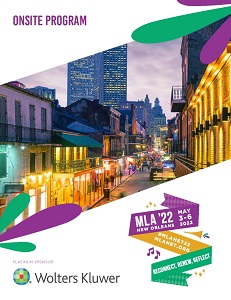Back
Paper: Research Abstract
Health Equity & Global Health
Session: Health Equity and Global Health Session 1
Developing a Stakeholder-Guided, Principles-Based Community Engagement Toolkit
Thursday, May 5, 2022
2:15 PM – 2:30 PM CT
Location: 352
.jpg)
Allison Cruise
Visiting NLM Associate Fellow
Health Sciences Library & Informatics Center
Albuquerque, New Mexico
Presenter and Author(s)
Objectives: The National Library of Medicine’s Office of Engagement and Training (NLM OET) identified a need to expand community engagement and outreach initiatives for NLM and the Network of the National Libraries of Medicine (NNLM). This project was designed to explore how NLM and NNLM stakeholders define successful community engagement. Using these findings, the project ultimately sought to create a resource for NLM and NNLM stakeholders which could facilitate current and future engagement efforts. The author developed a community engagement toolkit for NLM and NNLM stakeholders as a resource to meet these goals.
Methods: Working definitions of community and community engagement were developed through collaboration between project partners in a shared document. Using the definitions, thoughts, resources and background data collected in this document, the author developed a set of principles of community engagement. This was an iterative process consisting of three draft documents. Once the third draft was ready, the team agreed on a set of interview questions. They then identified eleven stakeholders within NIH, NLM, and NNLM to interview using the predetermined set of questions. The third draft of the principles document was shared with all eleven of the interviewees, and the author incorporated feedback into this document throughout the interview phase. Following the conclusion of these interviews, the author created a community engagement toolkit that was informed by interview findings and final principles.
Results: Through the interview process, the author identified key themes and challenges to share with OET to inform future engagement and outreach decisions. These findings also helped to inform the community engagement toolkit. This toolkit is a nine-page document consisting of five identified principles. These principles are: trust, flexibility, respect, intentionality, and empowerment. Each principle is paired with a definition, and four of the five have at least one strategy. The defined strategies are paired with questions to consider, tools to use, and resources or examples where appropriate. The toolkit concludes with suggestions for what the toolkit user can do next.
Conclusions: This project represented an opportunity to explore and think critically about the meaning of community, community engagement, and what successful community engagement looks like. Collaboration was a fundamental part of the toolkit creation, from the definition stage to the final stage of identifying relevant and appropriate principles and strategies to share. The outcome of this project, a community engagement toolkit for NLM and NNLM stakeholders, is designed to be a thought-provoking tool for both beginning and experienced engagement and outreach leaders. Though its creation was informed by NIH, NLM, and NNLM stakeholders, it is a flexible and living document, with a paired principle and strategy framework which can be adapted to meet different organizational and community needs.
Methods: Working definitions of community and community engagement were developed through collaboration between project partners in a shared document. Using the definitions, thoughts, resources and background data collected in this document, the author developed a set of principles of community engagement. This was an iterative process consisting of three draft documents. Once the third draft was ready, the team agreed on a set of interview questions. They then identified eleven stakeholders within NIH, NLM, and NNLM to interview using the predetermined set of questions. The third draft of the principles document was shared with all eleven of the interviewees, and the author incorporated feedback into this document throughout the interview phase. Following the conclusion of these interviews, the author created a community engagement toolkit that was informed by interview findings and final principles.
Results: Through the interview process, the author identified key themes and challenges to share with OET to inform future engagement and outreach decisions. These findings also helped to inform the community engagement toolkit. This toolkit is a nine-page document consisting of five identified principles. These principles are: trust, flexibility, respect, intentionality, and empowerment. Each principle is paired with a definition, and four of the five have at least one strategy. The defined strategies are paired with questions to consider, tools to use, and resources or examples where appropriate. The toolkit concludes with suggestions for what the toolkit user can do next.
Conclusions: This project represented an opportunity to explore and think critically about the meaning of community, community engagement, and what successful community engagement looks like. Collaboration was a fundamental part of the toolkit creation, from the definition stage to the final stage of identifying relevant and appropriate principles and strategies to share. The outcome of this project, a community engagement toolkit for NLM and NNLM stakeholders, is designed to be a thought-provoking tool for both beginning and experienced engagement and outreach leaders. Though its creation was informed by NIH, NLM, and NNLM stakeholders, it is a flexible and living document, with a paired principle and strategy framework which can be adapted to meet different organizational and community needs.

.png)

